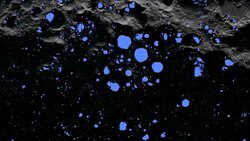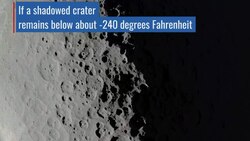Permanently shadowed crater

A permanently shadowed crater is a depression on a body in the Solar System within which lies a point that is always in darkness.[1][2]
As of 2019, there are 324 known permanently shadowed regions on the Moon.[3] Such regions also exist on Mercury[4] and Ceres.[5]
Location[]
Such a crater must be located at high latitude (close to a pole) and be on a body with very small axial tilt. The Moon has an axial tilt of about 1.5°; Mercury, 0.03°;[6] and Ceres, about 4°.[7]
On the Moon, permanent shadow can exist at latitudes as low as 58°; approximately 50 permanently shadowed regions exist in the 58°- 65° latitude range for both lunar hemispheres.[8]
The cumulative area of permanently shadowed lunar regions is about 31 thousand km2; more than half of it is in the southern hemisphere.[9]
Conditions inside craters[]
Craters of eternal darkness might be advantageous for space exploration and colonization, as they preserve sources of water ice[10] that can be converted into drinkable water, breathable oxygen, and rocket propellant.[11] Several of such craters show indications of water ice in their interiors, including Rozhdestvenskiy[12] and Cabeus craters[13] on the Moon, and Juling Crater on Ceres.[14]
The craters may also contain unusually high concentrations of helium-3.[15]
A business case analysis indicates that mining of propellants in the craters could become a profitable commercial enterprise.[16]

In some cases, peaks of eternal light are located nearby, that could be advantageous for solar power generation. For example, there are 2 peaks near Shackleton Crater that are illuminated a combined ~94% of a lunar year.[17]
Permanently shadowed regions have a stable surface temperature. On the Moon, the temperature hovers somewhere at or below 50 Kelvin.[18] Another temperatures estimate is 25 K to 70 K.[19] The low temperatures make the regions desirable locations for future infrared telescopes.[20][21]
On the other hand, computer simulations show that powerful solar storms can charge up the soil in permanently shadowed regions near the lunar poles, and may possibly produce "sparks" that could vaporize and melt the soil.[22][23]
There are other unique challenges of such regions: dark environments that restrict the ability of rovers to perceive their surroundings, cryogenic regolith that could be hard to move on, and communication interruptions.[24]
Planetary protection[]
In 2020, NASA has assigned "sensitive location" status to the Moon's permanently shadowed regions to avoid their contamination[25]
List[]
Below is an incomplete list of such craters:
The Moon:
Mercury:
Many such craters also exist on Ceres.[37] One example is Juling Crater, which is in almost permanent shadow.[38]
Research missions[]
Past[]
In 2009, LCROSS sent an impactor into a Cabeus crater, that resulted in detection of water in the ejected material.[39]
In 2012, The Lyman Alpha Mapping Project aboard NASA's Lunar Reconnaissance Orbiter has found that the permanently shadowed regions have a porous, powdery surface, that indicates the presence of water ice.[40]
In 2018, an analysis of the results of the Moon Mineralogy Mapper confirmed the existence of water ice deposits in permanently shadowed craters and crevices, with more abundance near the south pole.[41]
Planned[]
The proposed International Lunar Observatory mission involves a landing near the Malapert crater.[42]
Lunar Flashlight is planned to launch in 2021 as a secondary payload for the Artemis 1 mission.[43][44]
A camera called ShadowCam is being built that will be able to take high-resolution images of Permanently Shadowed Regions. It is a NASA instrument that will fly on board the Korea Pathfinder Lunar Orbiter (KPLO) in 2022.[45]
See also[]
- List of impact craters in Antarctica
- Peak of eternal light
- Lunar resources
References[]
- ^ https://lunar.gsfc.nasa.gov/images/lithos/LRO%20litho5-shadowedFinal.pdf
- ^ https://svs.gsfc.nasa.gov/11218
- ^ http://lroc.sese.asu.edu/psr/list
- ^ https://www.planetary.org/space-images/permanently-shadowed-radar-bright-mercury
- ^ Schorghofer, Norbert; Mazarico, Erwan; Platz, Thomas; Preusker, Frank; Schröder, Stefan E.; Raymond, Carol A.; Russell, Christopher T. (2016). "The permanently shadowed regions of dwarf planet Ceres". Geophysical Research Letters. 43 (13): 6783–6789. Bibcode:2016GeoRL..43.6783S. doi:10.1002/2016GL069368.
- ^ Planetary Fact Sheets, at http://nssdc.gsfc.nasa.gov
- ^ Schorghofer, N.; Mazarico, E.; Platz, T.; Preusker, F.; Schröder, S. E.; Raymond, C. A.; Russell, C. T. (6 July 2016). "The permanently shadowed regions of dwarf planet Ceres". Geophysical Research Letters. 43 (13): 6783–6789. Bibcode:2016GeoRL..43.6783S. doi:10.1002/2016GL069368.
- ^ https://meetingorganizer.copernicus.org/EPSC2012/EPSC2012-756.pdf
- ^ Crawford, Ian (2015). "Lunar Resources: A Review". Progress in Physical Geography. 39 (2): 137–167. arXiv:1410.6865. Bibcode:2015PrPG...39..137C. doi:10.1177/0309133314567585. S2CID 54904229.
- ^ https://www.space.com/41554-water-ice-moon-surface-confirmed.html
- ^ https://web.archive.org/web/20060213061216/http://www.space.com/scienceastronomy/solarsystem/moon_mountain_020326.html
- ^ Mitchell, Julie (2017). "Investigations of Water-Bearing Environments on the Moon and Mars". Bibcode:2017PhDT.......229M. Cite journal requires
|journal=(help) - ^ https://web.archive.org/web/20100122233405/http://www.planetary.org/news/2009/1113_LCROSS_Lunar_Impactor_Mission_Yes_We.html
- ^ https://www.nasa.gov/feature/jpl/nasa-dawn-reveals-recent-changes-in-ceres-surface
- ^ Cocks, F. H. (2010). "3He in permanently shadowed lunar polar surfaces". Icarus. 206 (2): 778–779. Bibcode:2010Icar..206..778C. doi:10.1016/j.icarus.2009.12.032.
- ^ Sowers, George F.; Dreyer, Christopher B. (2019). "Ice Mining in Lunar Permanently Shadowed Regions". New Space. 7 (4): 235–244. Bibcode:2019NewSp...7..235S. doi:10.1089/space.2019.0002.
- ^ Bussey D. B. J., McGovern J. A., Spudis P. D., Neish C. D., Noda H., Ishihara Y., Sørensen S.-A. (2010). "Illumination conditions of the south pole of the Moon derived using Kaguya topography". Icarus. 208 (2): 558–564. Bibcode:2010Icar..208..558B. doi:10.1016/j.icarus.2010.03.028.CS1 maint: multiple names: authors list (link)
- ^ http://lroc.sese.asu.edu/posts/96
- ^ http://lroc.sese.asu.edu/posts/979
- ^ https://science.nasa.gov/science-news/science-at-nasa/2008/09oct_liquidmirror/
- ^ https://web.archive.org/web/20060213061216/http://www.space.com/scienceastronomy/solarsystem/moon_mountain_020326.html
- ^ http://thescienceexplorer.com/universe/solar-storms-could-spark-soils-moons-poles
- ^ Jordan, A. P.; Stubbs, T. J.; Wilson, J. K.; Schwadron, N. A.; Spence, H. E.; Joyce, C. J. (2014). "Deep dielectric charging of regolith within the Moon's permanently shadowed regions". Journal of Geophysical Research: Planets. 119 (8): 1806–1821. Bibcode:2014JGRE..119.1806J. doi:10.1002/2014JE004648. S2CID 53533526.
- ^ https://www.nasa.gov/content/roving-in-the-permanently-shadowed-regions-of-planetary-bodies/
- ^ https://www.businessinsider.in/science/space/news/nasa-new-rules-to-protect-mars-and-moon-from-earth-germs/articleshow/76906055.cms.
- ^ http://lroc.sese.asu.edu/posts/96
- ^ http://lroc.sese.asu.edu/posts/979
- ^ Sanin, A. B.; Mitrofanov, I. G.; Litvak, M. L.; Malakhov, A.; Boynton, W. V.; Chin, G.; Droege, G.; Evans, L. G.; Garvin, J.; Golovin, D. V.; Harshman, K.; McClanahan, T. P.; Mokrousov, M. I.; Mazarico, E.; Milikh, G.; Neumann, G.; Sagdeev, R.; Smith, D. E.; Starr, R. D.; Zuber, M. T. (2012). "Testing lunar permanently shadowed regions for water ice: LEND results from LRO". Journal of Geophysical Research: Planets. 117: n/a. Bibcode:2012JGRE..117.0H26S. doi:10.1029/2011JE003971. hdl:2060/20140005994.
- ^ Sanin, A. B.; Mitrofanov, I. G.; Litvak, M. L.; Malakhov, A.; Boynton, W. V.; Chin, G.; Droege, G.; Evans, L. G.; Garvin, J.; Golovin, D. V.; Harshman, K.; McClanahan, T. P.; Mokrousov, M. I.; Mazarico, E.; Milikh, G.; Neumann, G.; Sagdeev, R.; Smith, D. E.; Starr, R. D.; Zuber, M. T. (2012). "Testing lunar permanently shadowed regions for water ice: LEND results from LRO". Journal of Geophysical Research: Planets. 117: n/a. Bibcode:2012JGRE..117.0H26S. doi:10.1029/2011JE003971. hdl:2060/20140005994.
- ^ https://web.archive.org/web/20060213061216/http://www.space.com/scienceastronomy/solarsystem/moon_mountain_020326.html
- ^ L. J. Harcke; et al. (2001). "Radar Imaging of Mercury's North and South Poles at 3.5 cm Wavelength" (PDF). Workshop on Mercury: Space Environment, Surface, and Interior: 36.
- ^ J. K. Harmon; et al. (1994). "Radar mapping of Mercury's polar anomalies". Nature. 369 (6477): 213–215. Bibcode:1994Natur.369..213H. doi:10.1038/369213a0.
- ^ "Ice on Mercury". NASA. Retrieved 13 August 2016.
- ^ https://www.nasa.gov/mission_pages/messenger/multimedia/messenger_orbit_image20121015_1.html
- ^ New evidence for surface water ice in small‐scale cold traps and in three large craters at the north polar region of Mercury from the Mercury Laser Altimeter, Ariel N. Deutsch, Gregory A. Neumann, James W. Head. 14 September 2017. Geophysical Research Letters, Volume 44, Issue 18. doi.org/10.1002/2017GL074723
- ^ "Permanently Shaded Polar Craters". NASA/Johns Hopkins University Applied Physics Laboratory/Carnegie Institution of Washington/National Astronomy and Ionosphere Center, Arecibo Observatory. 15 November 2012.
- ^ Schorghofer, Norbert; Mazarico, Erwan; Platz, Thomas; Preusker, Frank; Schröder, Stefan E.; Raymond, Carol A.; Russell, Christopher T. (2016). "The permanently shadowed regions of dwarf planet Ceres". Geophysical Research Letters. 43 (13): 6783–6789. Bibcode:2016GeoRL..43.6783S. doi:10.1002/2016GL069368.
- ^ https://www.jpl.nasa.gov/spaceimages/details.php?id=PIA21918
- ^ https://web.archive.org/web/20100122233405/http://www.planetary.org/news/2009/1113_LCROSS_Lunar_Impactor_Mission_Yes_We.html
- ^ https://www.space.com/14284-moon-permanently-shadowed-regions-water-ice.html
- ^ https://www.space.com/41554-water-ice-moon-surface-confirmed.html
- ^ https://www.spaceflightinsider.com/missions/space-observatories/international-lunar-observatory-new-astrophysical-perspective/
- ^ https://www.space.com/27388-nasa-moon-mining-missions-water.html
- ^ https://arstechnica.com/science/2019/07/nasas-large-sls-rocket-unlikely-to-fly-before-at-least-late-2021/
- ^ http://lroc.sese.asu.edu/posts/979
External links[]
- Dynamics of the Solar System
- Geological features on the Moon
- Astrogeology stubs



